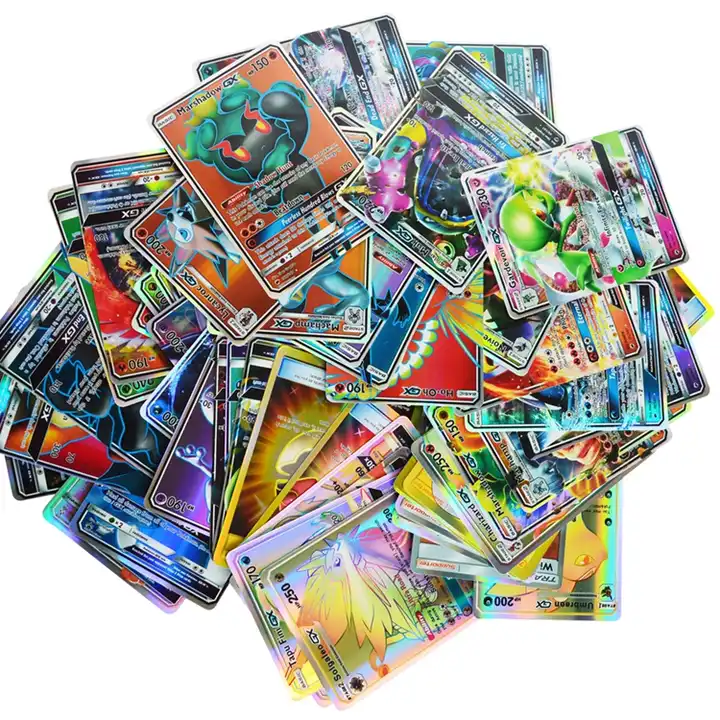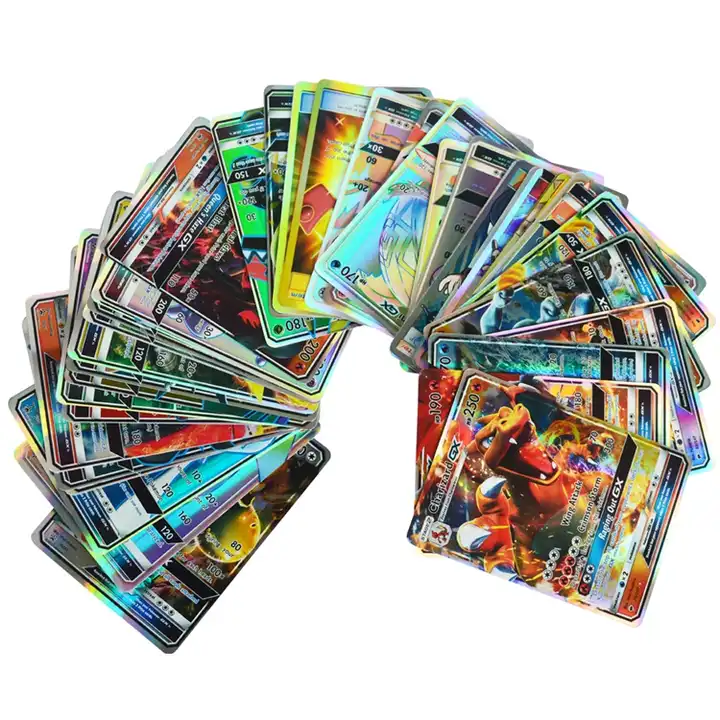Holo cards are printed cards that use holographic or hologram-style materials to create shifting rainbow effects, depth, and movement when viewed from different angles. They are widely used in trading cards, game cards, business cards, event passes, and collector editions because the sparkling finish makes the artwork look more vivid and premium.
Modern holo cards typically combine high-quality card stock with holographic film or specialized holographic paper, and can be finished with lamination, varnish, or UV coating for better durability. By adjusting how much of the surface is holographic, brands and creators can decide whether to highlight only logos and key graphics or to cover the full card face with a dazzling effect.

Why are Holo Cards so popular?
Holo cards stand out immediately in any deck or product lineup because the surface catches light and creates dynamic color patterns, which strongly attracts attention on shelves and in social media photos. Collectors and players often treat holo versions as “special pulls” with higher perceived rarity and value, so they help drive engagement, trading, and repeat purchases.
For brands and creators, holo cards also act as miniature billboards: the combination of premium feel, unique shine, and custom artwork reinforces brand image and storytelling. When used for limited editions, fan benefits, or influencer collaborations, holo cards can turn a simple printed item into a memorable collectible that people are eager to keep and display.
Typical applications of Holo Cards
Holo cards are extremely flexible and can be tailored to many industries and scenarios. Some of the most common uses include:
Custom trading cards for games, anime, fantasy characters, or original IP.
Collectible cards for sports teams, e-sports clubs, streamers, and fan communities.
Premium business cards or membership cards that need to look luxurious and memorable.
Event badges, VIP passes, and limited coupons with anti-counterfeiting and brand-display needs.
Educational or flash cards that use holo elements to increase engagement for kids and learners.
In each of these scenarios, the holographic effect helps differentiate the card from ordinary prints and adds a sense of exclusivity and fun. Because holo materials can be combined with different shapes, die-cuts, and packaging styles, they also work well as part of a larger branded product set.
What makes custom Holo Cards special?
Custom holo cards allow complete control over artwork, layout, holographic coverage, and finishing, so creators can align every detail with brand positioning or storytelling. Instead of using a generic template, you can define character poses, icons, stats, QR codes, lore text, and even hidden design elements that only reveal under certain lighting.
Because of the unique visual impact, custom holo cards often feel more “collectible” than standard prints, which can support higher pricing, limited pre-orders, and gamified campaigns. At the same time, modern printing technology makes it possible to run both small and large batches efficiently, so independent creators and brands can test new ideas without committing to huge volumes.
Key design considerations for Holo Cards
Designing effective holo cards is not only about adding rainbow foil everywhere; it is about balancing readability, aesthetics, and print feasibility. Some practical design principles include:
Use contrast wisely: dark colors, bold typography, and simple shapes usually read better on holographic backgrounds.
Leave breathing space: overly busy layouts compete with the holographic effect and can make important information harder to see.
Test under different lighting: strong reflections can hide details, so checking both bright and soft light conditions helps optimize the final look.
Prepare high-resolution files and proper bleed: 300 dpi artwork and adequate bleed/trim margins reduce the risk of blurry images or cut-off elements.
It is also helpful to decide early whether the holographic effect should cover the entire card or only certain zones, because this will influence where to place logos, text, and character art. For double-sided printing, designers typically pay special attention to how front and back layouts align, especially when using thin borders or edge effects.
Material and finish options for Holo Cards
The core of a holo card is the combination of paper or board and the holographic layer, which together control stiffness, thickness, and shine. Common choices include premium art paper, blue or black-core board for game and trading cards, and specialized holographic or metallic substrates for extra depth.
Finishes such as glossy or matte lamination, UV coating, and varnish help protect the print from scratches and fingerprints while fine-tuning the visual style. Optional details like rounded corners, textured or linen surfaces, and colored edges can further enhance the tactile experience and perceived value of the card.
Advantages of Holo Cards for brands and creators
Holo cards offer both visual and strategic advantages in marketing, community building, and product design. Key benefits include:
Strong differentiation: the holographic surface instantly sets the product apart from standard printed cards or flat packaging.
Higher perceived value: consumers and collectors usually associate holo finishes with premium editions, making them more willing to buy, trade, or keep the cards.
Emotional connection: unique designs, limited runs, and shimmering effects can turn cards into souvenirs that fans keep for years.
Versatility: the same production technology can support small testing runs, game expansions, loyalty programs, and co-branded campaigns.
For independent artists, holo cards can also serve as compact merch items that are easy to ship and attractive for conventions or online stores. Businesses, in contrast, may use them as part of broader packaging and display solutions to upgrade unboxing experiences.

Why choose XingKun for custom Holo Cards?
XingKun is a specialized printing and packaging manufacturer established in 2004, with a long history in custom products such as playing cards, flash cards, paper boxes, plastic boxes, display stands, and other promotional materials. This deep experience in both card printing and packaging gives XingKun a strong understanding of how holo cards must perform in real-world usage, from shuffling and frequent handling to shipment and retail display.
The company positions itself as a one-stop printing and packaging partner, providing integrated services that cover design support, printing, finishing, and export logistics. By centralizing these steps, XingKun helps clients save time, reduce communication friction with multiple suppliers, and lower total project costs.
XingKun’s production strength and quality control
XingKun is equipped with advanced printing machines, including Heidelberg CD102 four-color and Heidelberg XL75 six-color presses, which support high-precision, high-volume color reproduction suitable for detailed holo card artwork. These devices enable stable color consistency across large runs so that character art, logos, and gradient effects appear accurate and vivid on holographic substrates.
Backed by an experienced professional team, XingKun focuses on combining technology and art, paying attention to both mechanical accuracy and creative presentation. Systematic quality control covers color matching, registration, cutting, and packaging, helping ensure that each batch of holo cards meets the project’s technical and visual requirements.
Customization flexibility with XingKun
As a medium-sized supplier, XingKun emphasizes flexibility and responsiveness, which is critical for customized holo card projects. The company supports a wide range of materials, structures, and finishing methods, allowing creators to tailor thickness, size, lamination, and holographic coverage according to their own game mechanics, collector expectations, or brand guidelines.
Typical lead times are around 7–15 days from order to export shipment, with the ability to handle urgent samples or rush orders in approximately 3–7 days when necessary. This responsive schedule helps clients align printing with launch dates, convention calendars, or marketing campaigns without sacrificing quality.
One-stop packaging solutions around Holo Cards
Beyond the cards themselves, XingKun also produces display stands, custom paper boxes, plastic boxes, and other packaging components, enabling cohesive presentation of holo card products. Game creators or brands can design entire sets that include custom decks, rigid boxes, tuck boxes, windowed packaging, and promotional inserts, all matched in color and branding language.
This integrated approach simplifies coordination, because the same team handles both card production and outer packaging dimensions, tolerances, and structural design. As a result, cards fit better in their boxes, visual styles remain consistent, and the overall unboxing experience feels more deliberate and professional.
How to start a Holo Cards project with XingKun
When starting a holo cards project, it is useful to first define the purpose of the cards, target users, and desired print specifications such as size, thickness, and quantity. Clear information about game rules, character lists, or collectible tiers helps organize card content and layout structures efficiently.
After confirming the project outline, clients can provide artwork files or design drafts to XingKun, which can then guide them on technical aspects like bleed, color profiles, foil coverage, and finishing choices. Once details are finalized, XingKun can arrange sample production for confirmation before mass printing, allowing adjustments in color, holographic area, or packaging if needed.

Frequently asked questions about Holo Cards
1.What is the difference between holo cards and metallic cards?
Holo cards use holographic surfaces that split light into multiple colors and create a sense of depth and motion, so the visual changes when you tilt the card. Metallic cards rely on metallic ink or foil to create a flat mirror-like reflection, which usually looks shiny but does not produce the same rainbow or 3D effect.
2.Are holo cards more durable than standard cards?
Holo cards can be as durable as standard cards when printed on high-quality card stock and protected with suitable lamination or coating. The holographic layer itself is generally robust, but proper handling and storage are still important, especially for collectors who want to preserve mint condition.
3.Can small creators afford custom holo cards?
Yes, many modern printers, including companies specialized in custom cards, support flexible order quantities, which allows small creators to start with lower volumes to test their designs and market response. By planning the set size and packaging efficiently, independent artists and brands can control cost while still enjoying the premium impact of holo finishes.
4.What information is needed before requesting a quote from XingKun?
To receive an accurate quote, it is helpful to share details like card size, thickness, quantity, number of designs, desired materials, finishing options, and whether additional packaging such as boxes or display stands is required. Providing sample images or reference styles can also help XingKun’s team understand the desired holo effect and propose suitable technical solutions.
5.How long does XingKun usually take to produce holo cards?
Standard production and export for custom printed products are often completed within about 7–15 days after order confirmation, depending on complexity and volume. For urgent projects, XingKun can normally support samples or rush jobs in roughly 3–7 days to help clients meet tight launch schedules.
































